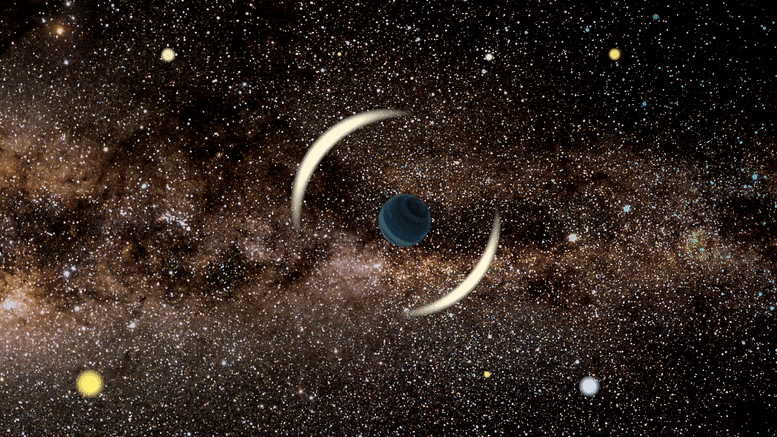The artistic impression of a gravitational microlens event of a free-floating planet. Photo credit: Jan Skowron / Astronomical Observatory, University of Warsaw
Our galaxy may be teeming with rogue planets that are not tied to any star. An international team of scientists, led by Polish astronomers, has announced the discovery of the smallest Earth-sized free-floating planet found to date.
Over four thousand extrasolar planets have been discovered to date. Although many of the known exoplanets do not resemble those in our solar system, they have one thing in common: they all orbit a star. Theories of planet formation and evolution, however, predict the existence of free-floating (rogue) planets that are not gravitationally tied to any star. Indeed, several years ago, Polish astronomers from the OGLE team at the Astronomical Observatory of the University of Warsaw provided the first evidence of the existence of such planets in the Milky Way. Write in Astrophysical diary lettersOGLE astronomers announced the discovery of the smallest rogue planet found to date.
Exoplanets can only rarely be observed directly. Typically, astronomers find planets by observing the light from the planet’s host star. For example, when a planet crosses in front of the disk of its parent star, the observed brightness of the star decreases periodically by a small amount, which leads to so-called transits. Astronomers can also measure the star’s motion caused by the planet.
Free-floating planets emit practically no radiation and, by definition, do not orbit a host star, so that they cannot be detected with conventional methods of astrophysical detection. Even so, rogue planets can be discovered using an astronomical phenomenon known as a gravitational microlens. The microlens derives from Einstein’s general theory of relativity – a massive object (the lens) can bend the light of a bright background object (the source). The gravity of the lens acts like a giant magnifying glass, bending and magnifying the light from distant stars.
“When a massive object (a star or planet) moves between an observer on Earth and a distant source star, its gravity can deflect and focus light from the source. The observer will measure a brief brightening of the source star, ”explains Dr. Przemek Mroz, postdoctoral fellow at the California Institute of Technology and lead author of the study. “The chances of observing microlenses are extremely slim, since three objects – source, lens and observer – have to be aligned almost perfectly. If we were to observe just one source star, we would have to wait nearly a million years for the source to be microlenshaped, ”he adds.
For this reason, modern studies looking for gravity microlens events monitor hundreds of millions of stars in the center of the Milky Way, where the chances of microlenses are greatest. The OGLE survey – conducted by astronomers from Warsaw University – conducts one of these experiments. OGLE is one of the largest and longest sky measurements and was commissioned over 28 years ago. Currently, OGLE astronomers are using a 1.3-meter Warsaw telescope at the Las Campanas Observatory in Chile. On every clear night, they point their telescope at the central regions of the galaxy and observe hundreds of millions of stars in search of those that change their brightness.
The gravitational microlens does not depend on the brightness of the lens, so it enables the study of faint or dark objects such as planets. The duration of microlens events depends on the mass of the lens object. The less massive the lens, the shorter the microlens event. Most of the observed events, which typically last several days, are caused by stars. Microlens events attributed to free-floating planets have timescales of barely a few hours. By measuring the duration of a microlens event (and the shape of its light curve) we can estimate the mass of the lens object.
The scientists announced the discovery of the shortest microlens event ever found, dubbed OGLE-2016-BLG-1928, with a timescale of just 42 minutes. “When we first discovered this event, it was clear that it must have been caused by an extremely small object,” says Dr. Radoslaw Poleski from the Astronomical Observatory of the University of Warsaw, co-author of the study. In fact, models of the event show that the lens must have been less massive than Earth, it probably was one Mars-mass object. Additionally, the lens is likely a rogue planet. “If the lens were to orbit a star, we would see its presence in the light curve of the event,” adds Dr. Poleski added. “We can rule out that the planet has a star within about 8 astronomical units (the astronomical unit is the distance between the earth and the sun).”
OGLE astronomers provided the first evidence of a large population of rogue planets in the Milky Way a few years ago. However, the newly discovered planet is the smallest rogue world ever found. “Our discovery shows that free-floating planets with low mass can be recorded and characterized with ground-based telescopes,” says Prof. Andrzej Udalski, PI of the OGLE project.
Astronomers suspect that free-floating planets actually formed in protoplanetary disks around stars (as “ordinary” planets) and were ejected from their superordinate planetary systems after gravitational interactions with other bodies, for example with other planets in the system. Theories of planet formation predict that the ejected planets should typically be smaller than Earth. Studying free-floating planets enables us to understand the turbulent past of young planetary systems like our solar system.
The search for free-floating planets is one of the scientific drivers behind the Nancy Grace Roman Space Telescope, which is currently being built by NASA. The observatory is scheduled to start operating in the mid-2020s.
Due to the brevity of the event, additional observations from the Korea Microlensing Telescope Network (KMTNet) were required to characterize the event. KMTNet operates a network of three telescopes – in Chile, Australia and South Africa.
Reference: “A Candidate Terrestrial Mass Rogue Planet Discovered in the Shortest Timescale Microlens Event” by Mroz, P., Poleski, R., Gould, A. et al., October 29, 2020, Astrophysical diary letters.
DOI: 10.3847 / 2041-8213 / abbfad
arXiv: 2009.12377
The discovery would not be possible without long-term observations of the OGLE sky survey. The project is one of the largest and longest sky measurements and was commissioned over 28 years ago. One of the first goals of the OGLE survey was to find and study dark matter using the gravitational microlens technique. Current studies cover a wide range of topics – finding exoplanets, studying the structure and evolution of the Milky Way and neighboring galaxies, studying variable stars, quasars, transients and bodies of the solar system.



